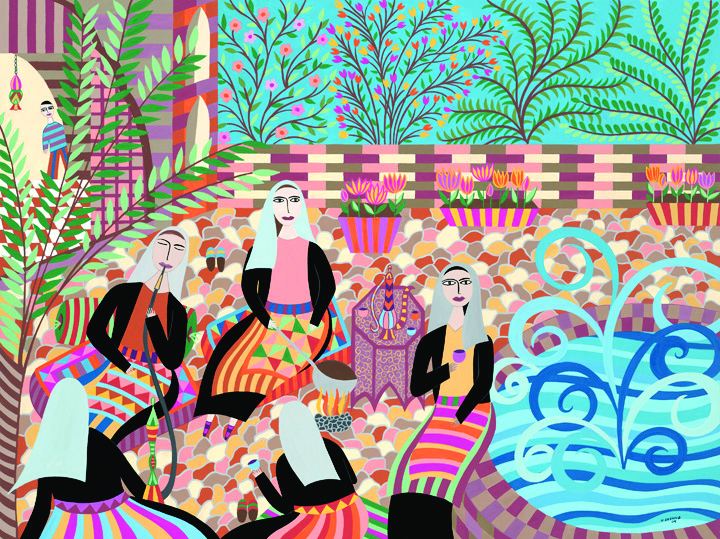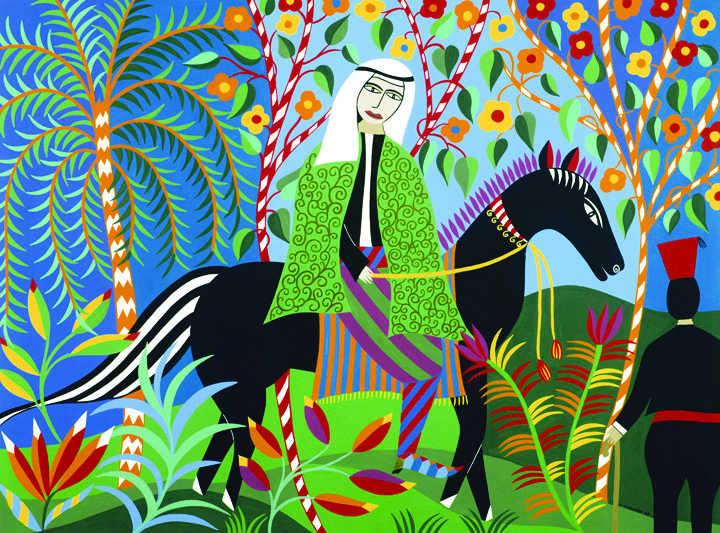
Across the Potomac, Helen Zughaib could see the Pentagon burning from her home in Washington, D.C. on Sept. 11, 2001. Soon enough, phone calls poured in from the painter’s family and friends in the Middle East. They called from Lebanon where she was born as well as from Jordan and Syria. They called to offer their support in the wake of a grisly national trauma, but neither Zughaib nor her loved ones could fully understand at that moment just how that trauma would manifest.
The next day, Zughaib says a stranger spit in her face. It was then she began to understand the complexity of the trauma: To be of Middle Eastern descent in America was now to be an object of fear — and hatred.
“Living in this town, here in Washington after 9/11, was such an eye-opening experience for me,” Zughaib says over the phone from the same apartment across the river. “All of a sudden people are looking at me and saying, ‘Where are you really from?’ What they’re really trying to get at is: Are you from the Middle East?”
As the daughter of a Syrian immigrant who went on to work for the U.S. Department of State and a college-educated American from upstate New York, Zughaib had always lived with one foot in the West, one in the Middle East. Her art is a reflection of that duality, blending elements of Western artistic movements — the non-naturalistic color of Fauvism, the multiple vantage points of Cubism, the cultural references of pop art — with foundational practices in Arabic art — the illusion of infinity that comes from regular tessellation, the hypnotic patterns of floral arabesque, the bluntness of two-dimensionality.
So while the 9/11 attacks initially made Zughaib reluctant to discuss her Middle Eastern heritage, the pull of her artistic mission grew stronger. The need to bridge the gap between East and West was more essential than it ever had been.
She looked no further than her father, Elia, for inspiration. Though he was reluctant, he agreed to work with her on the project. Weaving folktales from Elia’s native land with the story of his life — from being forced from his home in Syria in the early 1940s to finally immigrating to the U.S. during the Lebanese civil war in 1975 — Zughaib created a series of gouache paintings simply titled Stories My Father Told Me, now on display at Macky Auditorium through Boulder Museum of Contemporary Art.

The collection took more than a decade to create, beginning in 2003 — at her mother’s suggestion — and ending in 2015 when Elia handed his daughter the 24th story and informed her that was the final installment. At 92, Zughaib holds on to the hope that he’s got another story or two to give.
Once upon a time not so long ago, the hakawati — Arabic for storyteller — played a crucial role in Middle Eastern cultures. In villages and town centers, large crowds gathered to hear the hakawati share tales and folklore with wit and wisdom. Together, communities remembered their past, learned lessons, healed from traumas and came together as a united force, all through storytelling.
Together, Zughaib and her father continue in the tradition of the hakawati so that the global community might remember, learn, heal and unite.
As with all of Zughaib’s work, Stories My Father Told Me creates a kaleidoscopic-version of reality. It’s a chore not to vocalize delight as you take in snaking vines of arabesque wrapped loosely around repeated geometric patterns built of contrasting blocks of color — a cheerful, Technicolor Tim Burtonesque world. It’s a childlike wonder her paintings inspire, but not without demanding adequate attention in return.
Underneath the beauty of his daughter’s paint, Elia’s stories chronicle the root of human injustice, of the battles for power that have uprooted families for millenia, of the denial of home that has created a world of displaced “others.”
“It’s beautiful. It’s expressive,” says curator Jennifer Heath. Heath, an author and former arts reporter for the Rocky Mountain News, met Zughaib a decade or so ago while Heath was traveling with a show she curated called The Veil: Visible & Invisible Spaces. The show explored cliché and stereotypes about the Islamic veil through work by 30 artists from the U.S., Europe, India and the Middle East.
Like Elia Zughaib, Heath’s father also worked for the U.S. State Department, meaning his daughter grew up around the world. She came of age in Afghanistan. Like Helen Zughaib, she understands both worlds. It’s what drew her to Zughaib’s work.
“It has both the quality of reality and unreality at the same time, and that becomes sort of mystical and dreamlike, but at the same time she’s saying stuff,” Heath says. “She is talking about real politics — real politik — things that are actually happening on the ground. And she also had the wisdom to get her father’s stories. Not everybody has that, you know. People are suddenly rushing to the DNA departments to [find out] who they are, [but] she had the wisdom to [collect his stories].
“Stories My Father Told Me … has this mosaic quality that is in [Middle Eastern] architecture, and it doesn’t look exactly like Helen’s. Helen has her own style and her own way of expressing things. But it reflects that. It resonates with that kind of storytelling. And it also talks about, to me, the fragmentation of what that world became. First, it’s close. It’s all about these communities, but at the same time you can feel the fragmentation to come”

When Elia Zughaib was born, Mount Lebanon, the governorate where Beirut is located, was just a few years removed from a famine that had, by some estimates, decimated the population by as much as 50%. Tensions in the Levant rose with the fall of the Ottoman Empire and the rise of WWII.
That tension trickled down through the generations, first driving Elia from his home in the ’40s, then displacing his children: first after the Six-Day War in 1967, then again after the Lebanese civil war in 1975.
Helen Zughaib left Syria for Lebanon as a young child. She was then forced to leave Lebanon at age 16 and finished school in Paris before heading to college in the States.
“I remember like yesterday,” Zughaib says of leaving Syria in the late ’60s. “I said, ‘When are we going to come back, Daddy?’ And he said, ‘You’ll be back in a week.” It was 35 years later that I did go back.”
She returned in 2011 behind a showing of her work. The Arab Spring broke out just a few months later.
If there’s something Helen Zughaib understands, it’s fragmentation.
But showcasing pain and loss is not the point of Zughaib’s work. It’s about compassion.
“Yes, there are differences in cultures,” Zughaib says, “there’s a difference in language, there’s differences in religions. But are we really that different? And the answer is no, because ultimately we share the same desires and needs as human beings.”
Zughaib began her Syrian Migration Series in 2011 as a way to humanize the Arab Spring and the resulting Syrian war that led to the largest migration in human history. The collection parallels The Migration Series by Jacob Lawrence that documented the northern migration of African Americans in the first half of the 20th century.
“Lawrence’s Migration, his 60th panel simply said, ‘And the migrants kept coming,’” Zughaib says. “He said that in 1940 and 1941 … it was prophetic. And here we are. Do we not learn? Why do we repeat history?”
ON THE BILL: Artist Talk with Helen Zughaib. 6:30 p.m. Wednesday, Sept. 18, BMoCA @ Macky, Andrew J. Macky Gallery, Macky Auditorium, 1515 Pleasant St., Boulder. Free. ‘Stories My Father Told Me’ is on display at BMoCA at Macky through Nov. 24.














